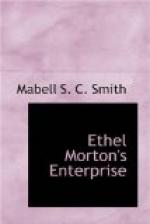It was late in the afternoon when they ferried across the river in a boat running on a chain, and took the train for the seat of Fayette County. As the daylight waned they found themselves travelling through a country lighted by a glare that seemed to spread through the atmosphere and to be reflected back from the clouds and sky.
“What is it?” Dicky almost whimpered, as he snuggled closer to his mother.
“Ask Grandfather,” returned Mrs. Morton.
“It’s the glare from the coke ovens,” answered Mr. Emerson. “Do you see those long rows of bee-hives? Those are ovens in which soft coal is being burned so that a certain ingredient called bitumen may be driven off from it. What is left after that is done is a substance that looks somewhat like a dry, sponge if that were gray and hard. It burns with a very hot flame and is invaluable in the smelting of iron and the making of steel.”
“That’s why they make so much here,” guessed Ethel Brown, who had been counting the ovens and was well up in the hundreds with plenty more in sight. “Here is where they make most of the iron and steel in the United States and they have to have coke for it.”
“And you notice how conveniently the coal beds lie to the iron mines? Nature followed an efficiency program, didn’t she?” laughed Roger.
“They turn out about twenty million tons of coke a year just around here,” Helen read from her guidebook, “and it is one of the two greatest coke burning regions of the world!”
“Where’s the other?”
“In the neighborhood of Durham, England.”
“It is a wonderful sight!” exclaimed Ethel Blue. “I never knew fire could be so wonderful and so different!”
Mr. Emerson’s search for Stanley Clark seemed to be a stern chase and consequently a long one. Here again the hotel clerk told him that Mr. Clark had gone on, this time to Washington, the seat of Washington County. He was fairly sure that he was still there because he had received a letter from him just the day before asking that something he had left behind should be sent him to that point, which was done.
As soon as the Record Office was open in the morning Mr. Emerson and Roger went there.
“We might as well check up on Hapgood’s investigations,” said Mr. Emerson. “They may be all right, and he may be honestly mistaken in thinking that his Emily is the Clarks’ Emily; or he may have faked some of his records. It won’t take us long to find out. Mr. Clark let me take his copy of Hapgood’s papers.”
It was not a long matter to prove that Hapgood’s copy of the records was correct. Emily Leonard had married Edward Smith; their son, Jabez, had married a Hapgood and Mary was their child. Where Hapgood’s copy had been deficient was in his failing to record that this Emily Leonard was the daughter of George and Sabina Leonard, whereas the Clarks’ Emily was the daughter of Peter and Judith Leonard.




